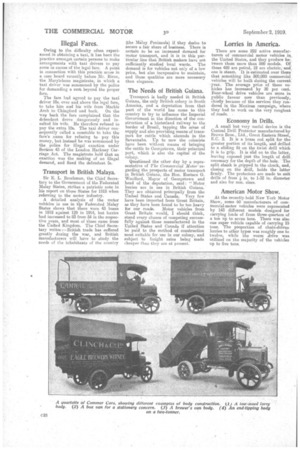Illegal Fares.
Page 6

If you've noticed an error in this article please click here to report it so we can fix it.
Owing to the difficulty often experienced in obtaining a taxi, it has been the practice amongst certain persons to make arrangements with taxi drivers to pay BUMS in excess of the legal fare. A point in connection with this practice arose in a case heard recently before Mr. Biron, the Marylebone magistrate, in which a taxi driver was summoned by the police for demanding a suit, beyond the proper fare.
The fare had agreed to pay the taxi driver 10s. over and above the legal fare, to take him and his wife from Marble Arch to Chingford and back. On the way back the fare complained that the defendant drove dangerously and insulted his wife. He therefore refused to pay the extra 10s. The taxi driver consequently called a constable to take the fare's name for refusing to pay this money, but instead he was summoned by the police for illegal exaction under Section 43 of the London Hackney Carriage Act. The magistrate held that an exaction was the making of an illegal demand, and fined the defendant 5s.
Transport in British Malaya.
Sir E. L. Brockman, the Chief Secretary to the GoVernment of the Federated Malay States, strikes a patriotic note in his report on these States for 1918 when referring to the motor industry_ A detailed analysis of the motor vehicles in use in tip Federated Malay States shows that there were 43 buses in 1918 against 129 in 1914, but lorries had increased to 83 from 54 in the respective years, and most of these came from the United Kingdom. The Chief Secretary writes :----British trade has suffered greatly during the war, and British manufacturers will have to study the needs of the inhabitants of the country (the Malay Peninsula) if they desire to secure a fair share of business. There is certain to be an increased demand for motor transport, and it is in this particular line that British makers have, not sufficiently studied local wants. The demand is for vehicles not only of a low price, but also inexpensive to maintain, and these qualities are more necessary than elegance.
The Needs of British Guiana.
Transport is badly needed in British Guiana, the only British colony in South America, and a deputation from that part of the world has come to this country to try to influence the Imperial Government in the direction of the construction of a hinterland railway to the border of Brazil, tapping the areas of supply and also providing means of transport for cattle which abounds in the Savannahs. Up to now the colonists have been without means of bringing the cattle to Georgetown, their principal port, which is also the capital of the colony.
Questioned the other day by a representative of The Commeretal Motor -regarding the prospects of motor transport in British Guiana, the Hon. Fustace G. Woolford, Mayor of Georgetown and head of the deputation, said " Motor lorries are in use in British Guiana. They are obtained principally from the United States and Canada. Very few have been imported from Great Britain, as they have been found to be too laeavy for our roads. Mace vehicles from Great Britain would, I should think, stand every chance of competing successfully against those manufactured in the United States and Canada if attention be paid to the method of construction most suitable for use in our colony, and subject to freight rates being made cheaper than they are at present.
Lorries in America.
There are some 222 active manufacturers of commercial motor vehicles in_ the United States, and they produce between them more than 500 models. Of. these 489 are petrol, 19 are electric, and one is steam. It is estimated over there' that something like 300,000 commercial vehicles will be built during the current -year. The average price of these vehicles has increased by 20 per cent. Four-wheel drive vehicles are more in public favour now than previously, chiefly because of the services they rendered in the Mexican campaign, where they had to work on the very roughest of roads. .
Economy in Drills.
A small but very useful device is the Central Drill Protector manufactured by Brown Bros., Ltd., Great Eastern Street, E.C. 2. It is a brass rod split for the greater portion of its length, and drilled to a sliding fit on the twist drill which it is to grip. It is slid on to the latter, leaving exposed just the length of drill necessary for the depth of the hole. The split shank is gripped in the chuck, and, closing on the drill, holds the latter firmly. The protectors are made to suit drills of from I,in. to 1-32 in diameter and also for mm. sizes.
American Motor Show.
At the recently-held New York Motor Show, some W manufacturers of commercial-motor vehicles were represented by 143 different models designed for carrying loads of from three-quarters of a ton up to seven tons. There was also one super vehicle capable of carrying 15 tons. The proportion of chain-driven lorries to other types was roughly one to twelve, while the worm drive was utilized on the majority of the vehicles up to five tons.






















